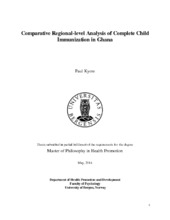Comparative Regional-level Analysis of Complete Child Immunization in Ghana
Master thesis
Permanent lenke
https://hdl.handle.net/1956/8212Utgivelsesdato
2014-05-19Metadata
Vis full innførselSamlinger
Sammendrag
Background: Achieving complete child immunization is a rare phenomenon in developing countries, however, even in the face of abject poverty and extreme deprivations, two regions in Ghana (PDRs) have thrived to do so. Effectively addressing variations in coverage among the regions, to inform immunization strategies in Ghana and elsewhere, requires understanding of such regions. Objective: Comparing the PDRs with each other, and with the other eight regions, the study investigated if there were regional-level characteristics that were unique to the PDRs, and that differentiated them from the other eight regions. Methods: With women response rate of 96.5%, a two- stage design was adopted. The first stage was analysis of data on 542 children (12-23months), to calculate the dependent variable complete/incomplete immunization" and then to compute the rate of complete immunization for each region. The second stage was cluster analysis of the regional-level factors, with the dependent variable. Results: Findings showed that besides complete child immunization rates of over 90%, the PDRs were also unique on frequent use of maternal health facilities, and on high maternal health care decision. However, exploratory hierarchical cluster analysis, applying squared Euclidean Distance, as the similarity measure, revealed not homogeneity, but great heterogeneity, in the socio-demographic composition and health care services availability-and-use characteristics of the PDRs. Conclusions: With evidence from the PDRs, it concluded that even with the poorest of all regions, with very disparate characteristics, it is possible to achieve high immunization coverage. Nevertheless, the GDHS data do not help to develop hypotheses to explain why the PDRs are positive deviant.
